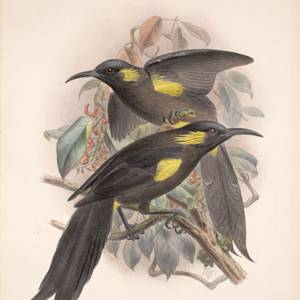Chinese Crested Tern
2013 CE • China
"First described in 1863, the Chinese crested tern has been a largely mysterious species and is arguably the world's most threatened seabird. After 21 specimens were collected in 1937 along the coast of Shandong Province, China, it wasn't until 2000 that any other sightings were confirmed: four adults and four chicks within a large colony of greater crested terns in the Matsu Islands, Taiwan. The discovery was big news in the ornithology world, which had generally considered the Chinese crested tern to be extinct. In the years since, breeding has been confirmed in five locations: three along the Chinese coast, plus an uninhabited island off the southwestern coast of South Korea and the Penghu Islands of Taiwan . . . Social attraction was the strategy for the Chinese crested tern project, the first major conservation effort for seabirds in the People's Republic of China . . . Social attraction involves decoys, recorded bird vocalizations, mirrors, scent and artificial burrows that work in concert to lure adult seabirds to restoration sites with the goal of establishing breeding colonies . . . In 2013, a tern restoration project was launched on Tiedun Dao, an uninhabited, densely vegetated, 2.58-hectare island in the Jiushan Islands, home to a former breeding colony of Chinese crested terns that was abandoned in 2007 in the wake of illegal egg harvesting." Since then, several other successful restoration colonies have been established, increasing the populations to over 100 for the first time in recorded history. Conservationists are cautiously hopeful that this restoration work shows a sign that the tern could be brought bounce back from the edge of extinction. "The Chinese crested tern is among the nearly one-third of seabird species threatened with extinction because of entanglement with fishing gear, reduction in food supplies, environmental contaminants, overharvest, and predation and other disturbances by invasive species."
Quote: Oregon State University, "Restoration of the critically endangered seabird," Phys.org, July 21, 2020.
Image: Oregon State University, CC BY-SA 2.0, via Wikimedia Commons


Learn about Maya Lin’s fifth and final memorial: a multi-platform science based artwork that presents an ecological history of our world - past, present, and future.

Discover ecological histories and stories of former abundance, loss, and recovery on the map of memory.

Learn how we can reduce our emissions and protect and restore species and habitats – around the world.

See how art can help us rethink the problems we face, and give us hope that each one of us can make a difference.

Help make a global memorial something personal and close to home. Share your stories of the natural world.

